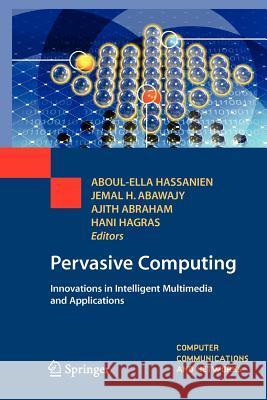Pervasive Computing: Innovations in Intelligent Multimedia and Applications » książka
Pervasive Computing: Innovations in Intelligent Multimedia and Applications
ISBN-13: 9781447125143 / Angielski / Miękka / 2012 / 461 str.
Pervasive Computing: Innovations in Intelligent Multimedia and Applications
ISBN-13: 9781447125143 / Angielski / Miękka / 2012 / 461 str.
(netto: 536,74 VAT: 5%)
Najniższa cena z 30 dni: 563,58 zł
ok. 16-18 dni roboczych.
Darmowa dostawa!
The main objective of pervasive computing systems is to create environments where computers become invisible by being seamlessly integrated and connected into our everyday environment, where such embedded computers can then provide inf- mation and exercise intelligent control when needed, but without being obtrusive. Pervasive computing and intelligent multimedia technologies are becoming incre- ingly important to the modern way of living. However, many of their potential applications have not yet been fully realized. Intelligent multimedia allows dynamic selection, composition and presentation of the most appropriate multimedia content based on user preferences. A variety of applications of pervasive computing and - telligent multimedia are being developed for all walks of personal and business life. Pervasive computing (often synonymously called ubiquitous computing, palpable computing or ambient intelligence) is an emerging ?eld of research that brings in revolutionary paradigms for computing models in the 21st century. Pervasive c- puting is the trend towards increasingly ubiquitous connected computing devices in the environment, a trend being brought about by a convergence of advanced el- tronic - and particularly, wireless - technologies and the Internet. Recent advances in pervasive computers, networks, telecommunications and information technology, along with the proliferation of multimedia mobile devices - such as laptops, iPods, personal digital assistants (PDAs) and cellular telephones - have further stimulated the development of intelligent pervasive multimedia applications. These key te- nologiesarecreatingamultimediarevolutionthatwillhavesigni?cantimpactacross a wide spectrum of consumer, business, healthcare and governmental domains.
This volume provides state-of-the-art coverage of the diverse topics related to pervasive computing and intelligent multimedia technologies. The use of different computational intelligence-based approaches to various problems in pervasive computing are examined, including video streaming, intelligent behavior modeling and control for mobile manipulators, tele-gaming, indexing video summaries for quick video browsing, web service processes, virtual environments, ambient intelligence, and prevention and detection of attacks to ubiquitous databases. Topics and features: includes a comprehensive overview, providing a thorough literature review; examines virtual reality technology, and mobile virtual environments; describes various approaches in ambient intelligence for home health care for the elderly and those suffering from Alzheimer s disease, and for volcano monitoring; investigates issues in web services and situation awareness in pervasive computing environments; explores wireless network applications.











